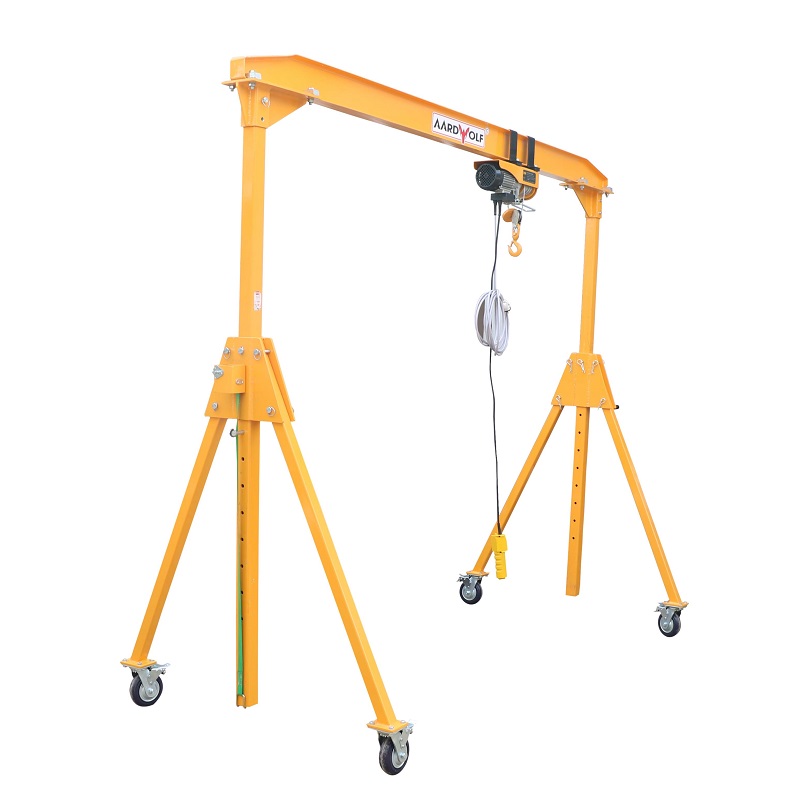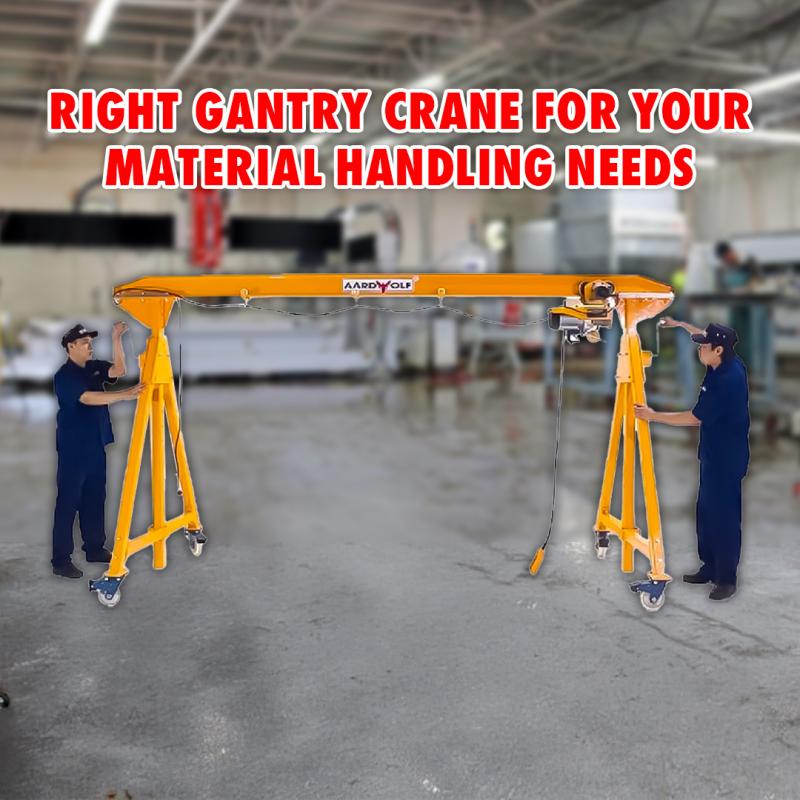



Cranes play an essential role in heavy industries like construction, manufacturing, logistics, and shipping. However, their substantial lifting power comes with inherent risks. This guide covers comprehensive safety practices to follow when operating an overhead or gantry crane, emphasizing the reliability and safety features offered by Aardwolf’s renowned crane and lifting solutions.
Overhead and gantry cranes are powerful lifting machines designed to move substantial loads efficiently. While overhead cranes are usually fixed on rails installed above the ground, gantry cranes, like the portable models from Aardwolf, are supported by legs running on wheels or tracks, enabling greater flexibility and portability.
The Aardwolf AGC-1000 Portable Gantry Crane exemplifies industry-leading safety and mobility:
Aluminum Construction: Lightweight yet strong, offering excellent corrosion resistance.
Load Capacity: Safely supports loads up to 1000 kg (2204 lbs).
Adjustable Height: Can reach up to 3.1 meters, providing adaptability to various workspace requirements.
Portability: Designed for quick assembly and easy relocation.
These features significantly reduce operational risks and enhance safety across various industries.

Recognizing the common hazards associated with crane operation is the first step toward effective risk mitigation:
Improperly secured loads can slip, creating severe safety risks. Causes include incorrect rigging techniques, inadequate inspections, and using unsuitable lifting equipment.
Cranes, despite their fixed paths, can collide with structures, equipment, or other cranes due to miscommunication or poor operator visibility.
Operating near power lines increases risks of electrocution. Maintaining proper clearance distances is essential.
Poor maintenance can cause mechanical breakdowns, resulting in dangerous load drops or crane malfunctions.
Operator mistakes due to insufficient training can cause overloading, incorrect positioning, or improper rigging practices.
Limited visibility can lead to accidental collisions and accidents involving personnel or property.
Certain industries experience heightened crane-related risks due to their operational environments:
The busy and dynamic nature of construction makes crane safety paramount. Portable cranes like the Aardwolf AGC-1000 enable precise load handling, reducing common hazards like dropped loads or collisions.
Manufacturing relies on cranes to move heavy components. Proper crane selection, such as those offered by Aardwolf, ensures safer and more efficient handling of machinery and materials.
In tight warehouse spaces, precise control and reliability are essential. Portable gantry cranes provide controlled movement, significantly reducing collision and drop risks.
Heavy-duty lifting at ports demands robust equipment and rigorous safety practices. Portable gantry cranes enhance maneuverability, optimizing operational efficiency and safety.
Implementing rigorous safety practices dramatically reduces crane-related risks:
Routine inspections help identify issues like worn cables or frayed ropes early. The Aardwolf AGC-1000’s modular design simplifies maintenance, making regular checks straightforward. Inspect structural components, wheels, casters, bolts, and the lifting mechanism before every use.
Ensure operators are certified and adequately trained. Training should include operation techniques, emergency procedures, and familiarity with specific crane models like Aardwolf’s portable cranes. Operators who understand the limits and capabilities of their equipment significantly decrease the likelihood of errors.
Secure and balance loads using proper lifting accessories. Aardwolf’s lifting clamps, hoists, and trolleys are specifically designed to securely handle various materials, significantly reducing the risk of load slippage.
Establish effective communication between crane operators and ground personnel. Using radios, hand signals, or designated signal personnel ensures precise crane movements, preventing collisions and accidents.
Clearly designate crane operation zones and restrict unauthorized access. Use safety barriers, cones, and warning signs to define these zones, significantly reducing injury risks.
Always keep overhead and gantry cranes at least 10 feet from power lines. If closer operation is required, follow OSHA guidelines by de-energizing and grounding power lines.
Aardwolf products are specifically engineered to improve safety and efficiency in crane operations:
Designed for secure grip and balanced load distribution, Aardwolf lifting clamps and slings prevent load drops. Regularly inspect clamps and slings before use to ensure optimum safety.
The AGC-1000’s adjustable height and easy portability ensure safer operations in diverse environments. Always assemble and adjust the crane on level ground, and follow the provided assembly guidelines to guarantee stability and structural integrity.
These hoists offer smooth and controlled lifting operations. Regular checks on the hoist’s brake mechanisms, chains, and hooks enhance reliability and safety.
Using the Aardwolf AGC-1000 in various industries highlights its practicality and safety benefits:
Construction: Easily lift concrete panels, heavy piping, or structural steel safely on site.
Manufacturing: Precisely position heavy machinery components or large assemblies.
Warehouses: Efficiently move pallets or heavy equipment, enhancing productivity without compromising safety.
Outdoor Installations: Safely install rooftop HVAC units or manage heavy loads during maintenance operations.
Proper crane maintenance extends equipment life and maintains safe operational conditions:
Conduct daily visual inspections to identify visible wear or damage.
Lubricate wheels, bearings, and moving components regularly, following Aardwolf’s recommended maintenance schedule.
Store the crane in a dry environment to prevent corrosion, especially for aluminum-based cranes like the AGC-1000.
Replace worn parts immediately with genuine Aardwolf replacement components to maintain structural integrity.
Adhering to stringent safety practices when operating an overhead or gantry crane significantly reduces workplace hazards. Leveraging high-quality lifting solutions like those from Aardwolf further enhances safety and efficiency. With routine inspections, comprehensive operator training, robust communication systems, and reliable lifting equipment, you can create a safer, more productive work environment.
When safety is a priority, choosing trusted equipment brands like Aardwolf ensures your crane operations remain safe, efficient, and compliant.
Regular inspections prevent mechanical failures and potential accidents, extending crane lifespan and ensuring operational safety.
Aardwolf products feature robust construction, easy mobility, adjustable configurations, and straightforward maintenance, reducing operational risks significantly.
Operators should receive initial certification training and ongoing refreshers annually or whenever new equipment is introduced.
Yes, Aardwolf’s portable gantry cranes are specifically designed for both indoor and outdoor use, offering corrosion resistance and stability in various environments.
By carefully implementing the detailed safety measures outlined above and choosing trusted lifting solutions like Aardwolf products, you can operate overhead and gantry cranes effectively, safely, and confidently.
References
1. How to operate a Jib Crane safely
3. Over brace jib crane wall mounted
5. Is a Jib Crane a Gantry Crane
6. Articulated Jib Crane Wall Mounted
8. Manual Counterbalance Crane
10. Over Braced Jib Crane Column Mounted
11. Powered counterbalance Crane
Đăng ký để nhận thông tin mới nhất về sản phẩm Aardwolf, ưu đãi đặc biệt và nhiều hơn nữa.
Bằng cách đăng ký, bạn đồng ý nhận email từ Aardwolf với tin tức, ưu đãi đặc biệt, khuyến mãi và thông tin khác. Bạn có thể hủy đăng ký bất cứ lúc nào.